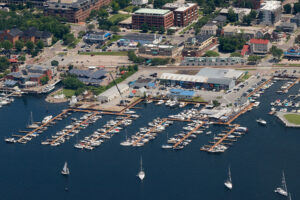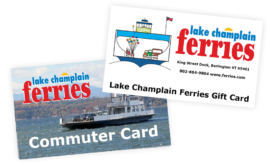
Since our founding in 1826, Lake Champlain Transportation Company ferries have been navigating the waters of Lake Champlain, providing an important form of transportation for both industry and recreation.
At the end of the 19th century, Burlington was the country’s third largest lumber port. Our ferries provided important commercial transportation for goods and lumber, as well as a luxurious form of leisure travel.
Through the years, with the advent of railroads and then the automobile, the steam-powered ferries nearly disappeared.
Today, modern ferries are an integral part of the lake. They are a welcome sight for both commuters and visitors.
Our Current Fleet
M/V Valcour
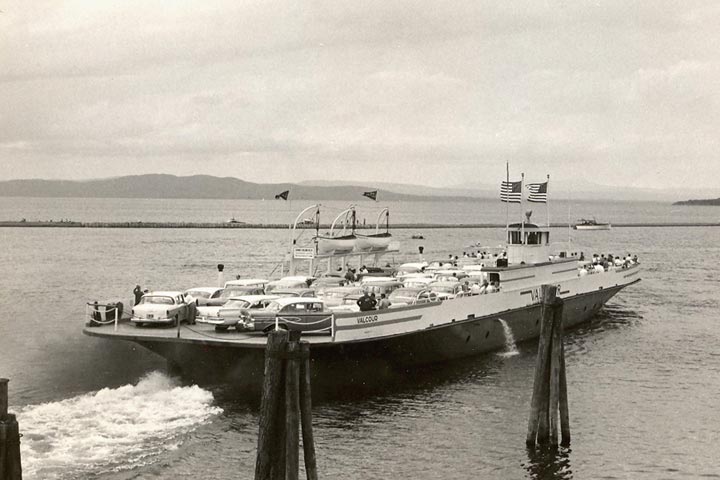 Valcour
ValcourYear: 1947
Location: Shelburne Shipyard, Shelburne, Vermont
There were two engine rooms with two engines in each. In 1990, the Valcour was re-powered on one end with a pair of D353 425 HP Caterpillar engines. By re-powering only one end, “single ending her” and removing the forward propellers and rudder it made her a little faster in the water and a lot more economical to run. She still serves the Burlington-Port Kent crossing.
M/V Grand Isle
Year: 1953
Location: Tampa, Florida
In 1973, the main deck was widened to accommodate larger trucks. Over the next several years, the trucks became longer, and in 1995 the Grand Isle was sailed to Panama City Florida where a local shipyard cut her in half and installed a 38-foot mid body and reconfigured her superstructure. A lounge and new bathrooms were also installed. Her new length was now 169 feet. In 2003, a pair of new Caterpillar 3412E 503 HP engines was installed. The Grand Isle now runs at the Charlotte-Essex crossing.
M/V Adirondack
 M/V Adirondack
M/V AdirondackYear: 1913
Location: Merrill-Stevens shipyard, Jacksonville, Floridat
She was sold to the Tocony-Palmyra Ferry Company of Philadelphia and put into service on the Delaware River under the new name, “Mount Holly”. In 1927, she went further north, to New York Harbor. Her new owners, the 34th Street Vehicular Ferry Company, kept the name Mount Holly and put her into service on the East River between Long Island City and the foot of East 34th Street in Manhattan.
In 1936, the national economy was in the midst of the Great Depression. The company failed, when the Mount Holly was a quarter of a century old. New bridges and tunnels were eliminating the need for ferryboats up and down the east coast, making her future gloomy indeed. Yet the Mount Holly survived.
On May 5, 1938, the expanding Chesapeake Bay Ferry Company purchased her. Major rebuilding of the superstructure was done at this time, giving her, to a large extent, the appearance that she has today. She was renamed the “Governor Emerson C Harrington II” and ran on Eastern Bay on the Chesapeake, connecting the communities of Clairborne and Romancoke.
The company was taken over by the State of Maryland in the early forties. In 1945, The Governor Emerson C. Harrington II was sent to the Baltimore Marine Repair Shops where her original steam- and coal-fired boilers where removed and replaced with a pair of 6-cylinder Atlas Imperial diesel engines.
The first span of the Chesapeake Bay Bridge opened in the summer of 1952, and the State of Maryland ceased its ferryboat operations. The Governor Emerson C. Harrington II was for sale again. The Lake Champlain Transportation Company, of Burlington Vermont, purchased her in 1954. The ferryboat that was about become the “Adirondack” (named for the mountain range in Upper New York State) entered a shipyard in Troy, New York, where her upper deck was disassembled and lowered to the car deck. This was done so she could be brought up the Champlain Canal with its low bridge clearances (13 feet) to Lake Champlain. The Adirondack’s second deck was restored to its original position in Burlington, where she began the current phase of her extraordinary and colorful career.
The Adirondack has sailed every summer between Burlington and Port Kent since 1954. Her only major modification during this time was the replacement of the Atlas Imperial engines with two 12V71 Detroit Diesel engines in 1970. The Adirondack is the oldest, in service, double-ended American ferryboat of all time! On January 15, 2013, the “Adi” will celebrate her 100th birthday.
M/V Champlain
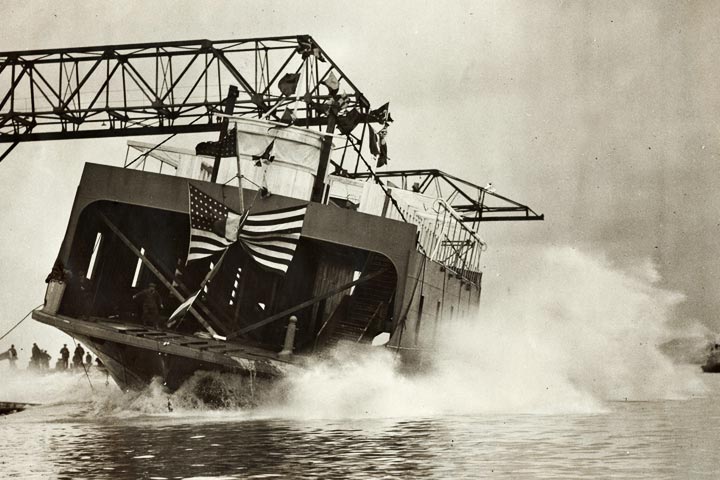 M/V Champlain
M/V ChamplainYear: 1930
Location: Baltimore, Maryland
With the opening of several bridges and tunnels The City of Hampton became one of several ferries to be disposed of by the Virginia Department of Highways in 1957. She ran in Hampton Rhodes on a crossing from Old Point Comfort (Fort Monroe) to Willoughby on the Norfolk side. Part of the crossing was in shallow water, so the City of Hampton was built with a flat bottom.
Lake Champlain Transportation purchased the City of Hampton in November of 1957, and made arrangements for her to be towed from Norfolk, Virginia and Waterford, New York. While in Waterford, the upper deck was carefully cut loose and lowered onto the main deck. This would give her enough clearance to pass under the low bridges during the northward trip to Lake Champlain. Renamed the “Champlain”, she joins the Valcour and the Adirondack on the Burlington-to-Port Kent crossing.
M/V Governor D. Aiken
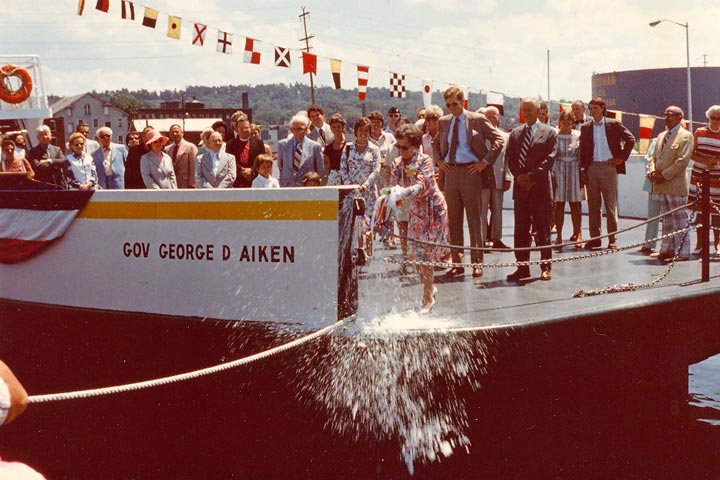
M/V Governor D. Aiken
Year: 1975
Location: Blount Marine, Warren, Rhode Island
The Aiken can carry up to 26 cars and is built strong enough to carry large trucks up to 40 tons. In the engine room are two Detroit 12V-71 diesel engines coupled to a Twin Disc MG-514 marine transmission, and a 20 KW generator provides the electrical power. Equipped with a hydraulic steering system and radar, the Aiken joined the Grand Isle on the Grand Isle-Cumberland Head crossing. Now the Aiken and the Grand Isle are operating on the Charlotte-Essex crossing.
M/V Plattsburgh
Year: 1984
Location: Eastern Marine, Panama City, Florida
The Plattsburgh joined the Grand Isle to keep up with a growing crossing of trucks and commuters.
M/V Evans Wadhams Wolcott
Year: 1988
Location: Houma Fabricators, Houma, Louisiana
The 196-foot EWW was built for the rugged winter weather and ice conditions on the Grand Isle-Cumberland Head crossing, and is equipped with stainless steel propellers and powered by two 775 HP Caterpillar 3508 diesel engines.
The EWW is our first ‘take-apart’ ferryboat. With the bridge clearance along the Champlain Barge Canal at 13 feet, she was built with flanges at the passenger lounge and pilothouse decks, which enabled us to un-bolt each deck, and using a crane, lower each deck to the main deck. Temporary steering and engine controls were installed from the relocated pilothouse, for the trip up the canal to Lake Champlain.
Upon arrival in Burlington, Vermont, the EWW was reassembled. In the past, we would torch cut the passenger and pilothouse decks apart and re-weld them. This was a very time-consuming job that required cleaning and painting of the burnt areas.
With the growing truck and commuter traffic the “EWW” was a welcome addition to the crossing.
M/V Vermont
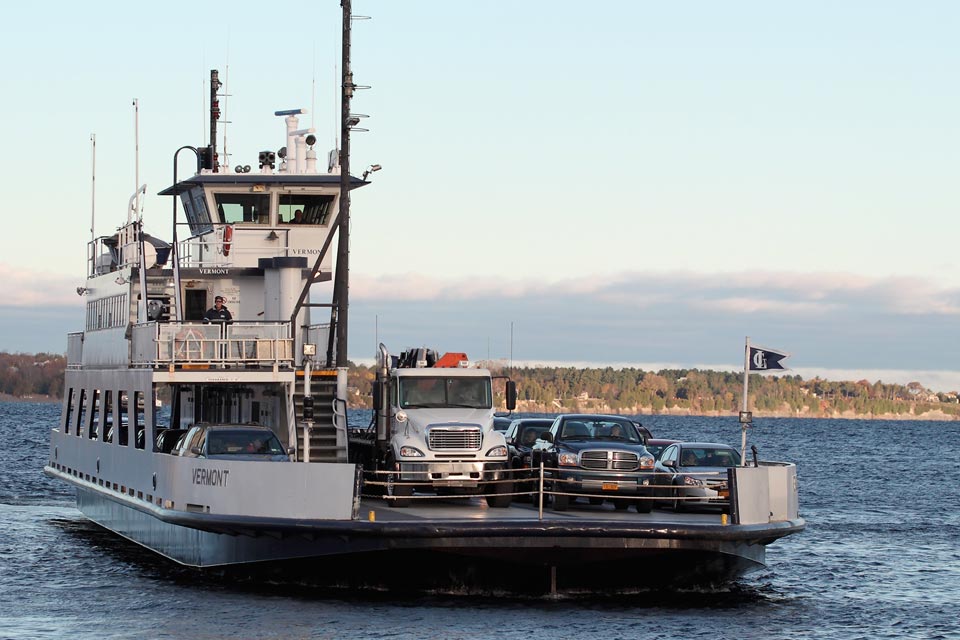 M/V Vermont
M/V VermontYear: 1992
Location: Houma Fabricators, Houma, Louisiana
The Vermont is our second ‘take-apart’ ferryboat. With the bridge clearance along the Champlain Barge Canal at 13 feet, the Vermont was built with flanges at the passenger lounge and pilothouse decks, which enabled us to un-bolt each deck, and using a crane, lower each deck to the main deck.
Temporary steering and engine controls were installed from the relocated pilothouse, for the trip up the canal to Lake Champlain. Upon arrival in Burlington, Vermont, the Vermont was reassembled. In the past we would torch cut the passenger and pilothouse decks apart and re-weld them. This was a very time-consuming job that required cleaning and painting of the burnt areas.
With the growing truck and commuter traffic the longer “Vermont” was a welcome addition to the crossing
M/V Cumberland
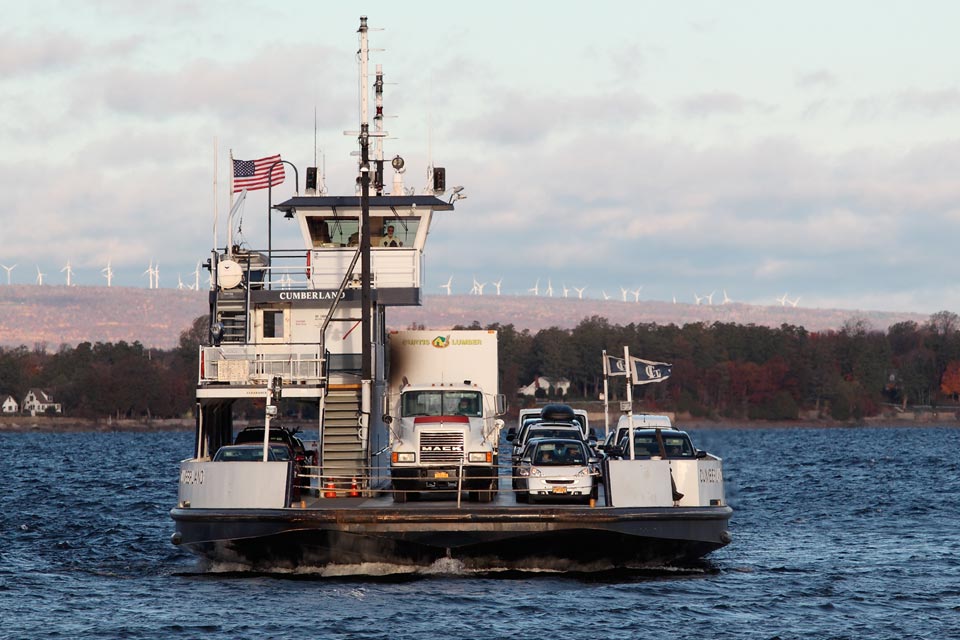
M/V Cumberland
Year: 2000
Location: Eastern Shipbuilding Group, Panama City, Florida
The Cumberland is our third ‘take-apart’ ferryboat. With the bridge clearance along the Champlain Barge Canal at 13 feet, she was built with flanges at the passenger lounge and pilothouse decks, which enabled us to un-bolt each deck, and using a crane, lower each deck to the main deck.
Temporary steering and engine controls were installed from the relocated pilothouse for the trip up the canal to Lake Champlain. Upon arrival in Burlington, Vermont the Cumberland was reassembled. In the past we would torch cut the passenger and pilothouse decks apart and re-weld them. This was a very time-consuming job that required cleaning and painting of the burnt areas.
With the growing truck and commuter traffic, the longer Cumberland was a welcome addition to the crossing.
M/V Raymond C. Pecor, Jr.
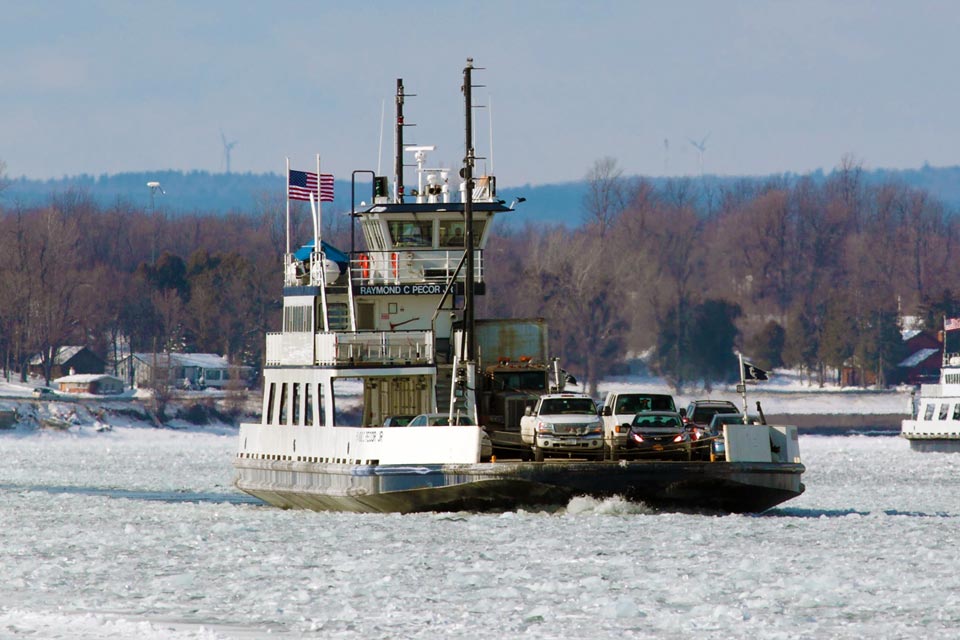
M/V Raymond C. Pecor, Jr.
Year: 2010
Location: Eastern Shipbuilding Group, Panama City, Florida
The Raymond C. Pecor Jr. is our fourth ‘take-apart’ ferryboat, similar to the construction of the Cumberland. With the bridge clearance along the Champlain Barge Canal at 13 feet, the RCP Jr. was built with flanges at the passenger lounge and pilothouse decks, which enabled us to un-bolt the decks, and, using a crane, lower each one to the main deck.
Temporary steering and engine controls were installed from the relocated pilothouse, and the trip was made up the canal to Lake Champlain. Upon arriving in Burlington, VT, the RCP Jr. was reassembled.
The Raymond C. Pecor Jr. is named after the previous owner of Lake Champlain Transportation, Ray Pecor Jr., who acquired LCT in 1976. Today the company is owned by his son, Ray Pecor III.

